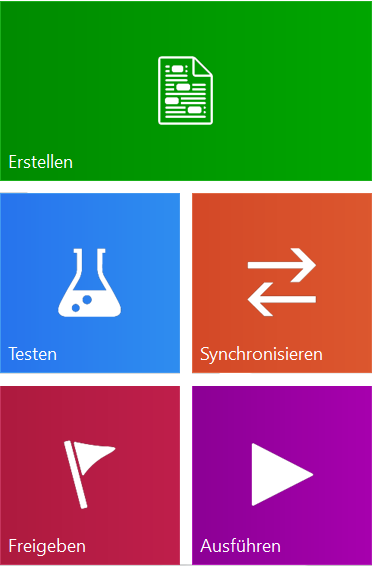Client Commands
General
The Client Commands area is used to create, test, synchronize, release, and execute client commands. Client commands are scripts that are modular in structure and can be executed on the console or on a client.

Client Commands
Concept of client commands
Client Commands are scripts that can run on both the console and a client. Client Commands therefore consist of console and/or client scripts, depending entirely on the area of application of the Client Command. Client Commands are generally used to install software, adjust configurations or interact with the system. Client Commands always consist of several individual commands/actions.
Console and Client Scripts
Client Commands are composed of console and client scripts. Both scripts or only one of the two scripts can be created, depending on the task the Client Command is to perform. The console script is executed on the computer on which the console is currently open. Once the console script has been successfully completed, the client script is started on the client. The console script is mainly used for the dynamic configuration of the client script.
Separate additional data
By using file repositories (see Distributed File Repositories), additional data from client commands, e.g. installation files, configuration files, etc., can be stored on different servers. This allows the network load to be balanced. When a client command is executed by a server/client, the actual client command data is queried from the ACMP server. The client command itself then instructs the server/client to reload the associated files from a file repository.
Phases
A Client Command goes through four phases before it is executed on the console/client. Each phase is listed as a separate sub-item in the navigation. Using the corresponding buttons, a Client Command can be transferred from one phase to the next or returned to a previous phase.
1. Create
In the Create phase, Client Commands can be created, edited, versioned, and managed. Furthermore, the scripts of a Client Command and its version history can be viewed.
2. Test
In the Test phase, Client Commands can be tested on selected clients. The test clients must be directly connected to the ACMP Server.
3. Synchronize
In the Synchronize phase, any additional files of a Client Command are distributed to the various file repositories.
4. Release
In the Release phase, any additional files of a Client Command are distributed to all file repositories (or at least some of them). The Client Command can now be released for use and is then available on the clients.
There is also the Execute option. Here, a log file can be viewed for each execution of a Client Command. This allows any problems that have occurred to be analyzed.
Since Client Commands need to be customized from time to time, they can be versioned. This means that there can be different versions of a Client Command. This allows a new version to be created from a Client Command that is currently in use (4th phase). This new version must now go through the first three phases again. Only in the 4th phase does the new version replace the old version.
Different rights can be assigned for working with Client Commands.
5. Execute
In the Execute phase, all Client Commands that are ready for execution are displayed. You also receive information about Client Commands that have already been executed.


